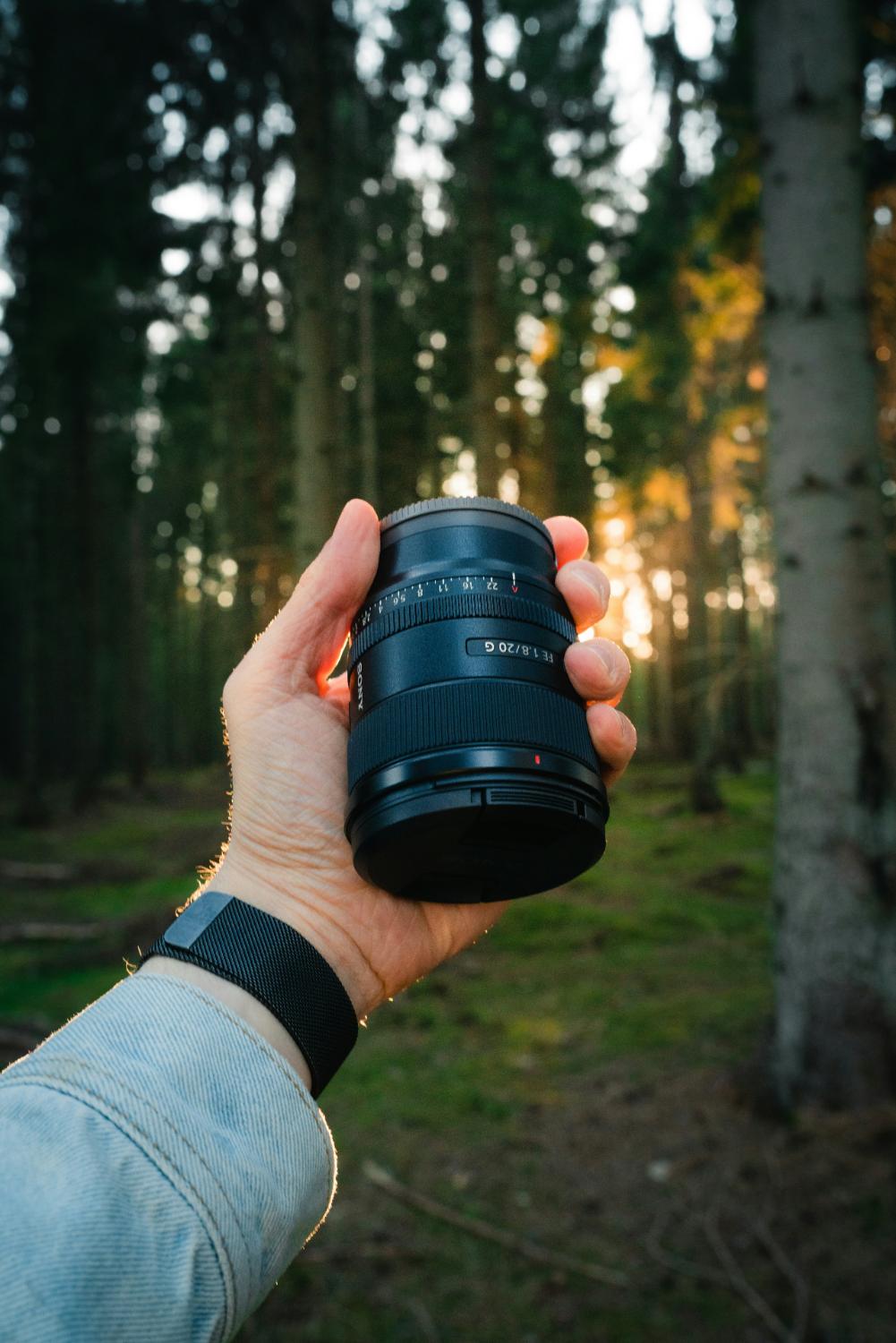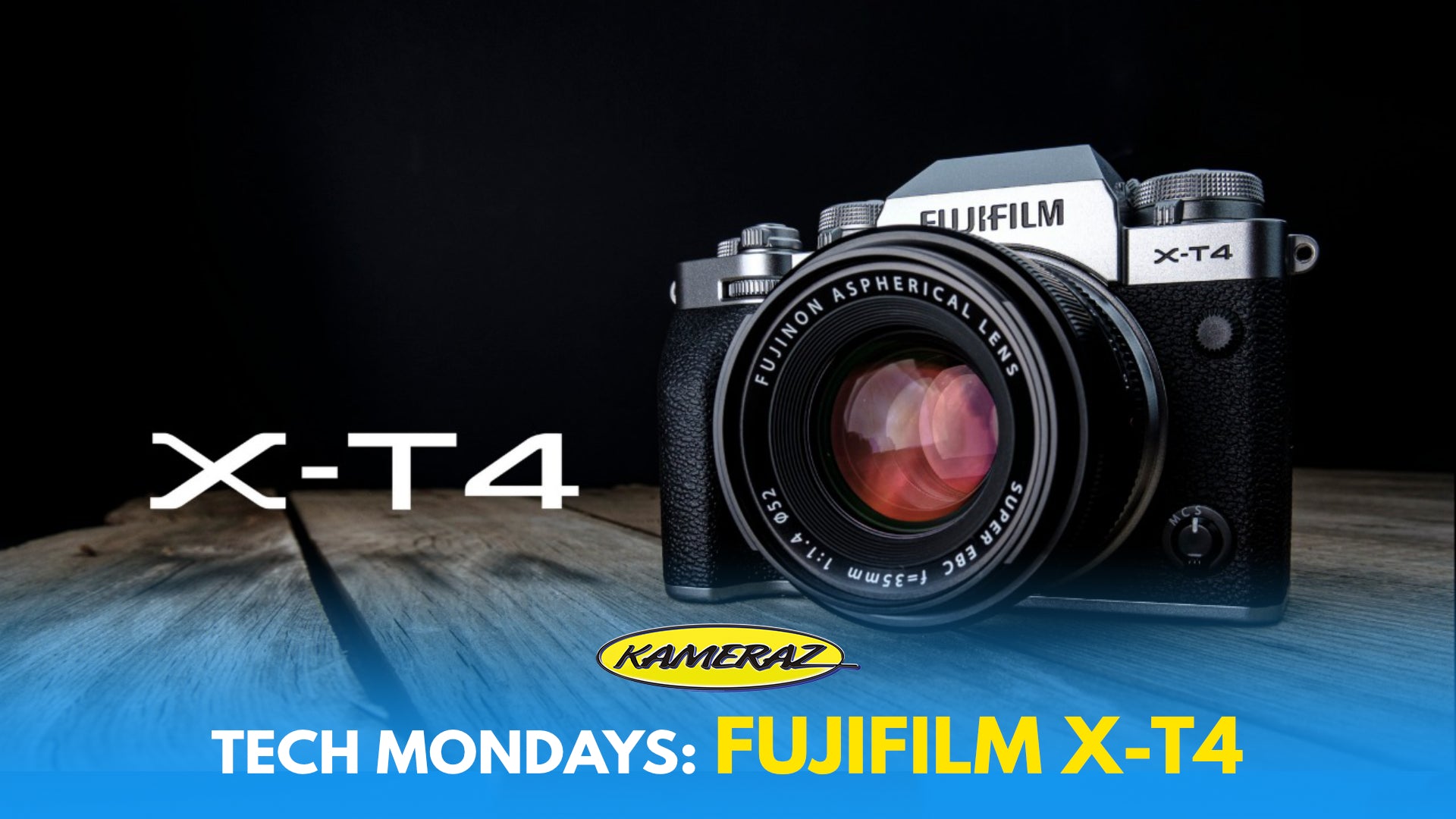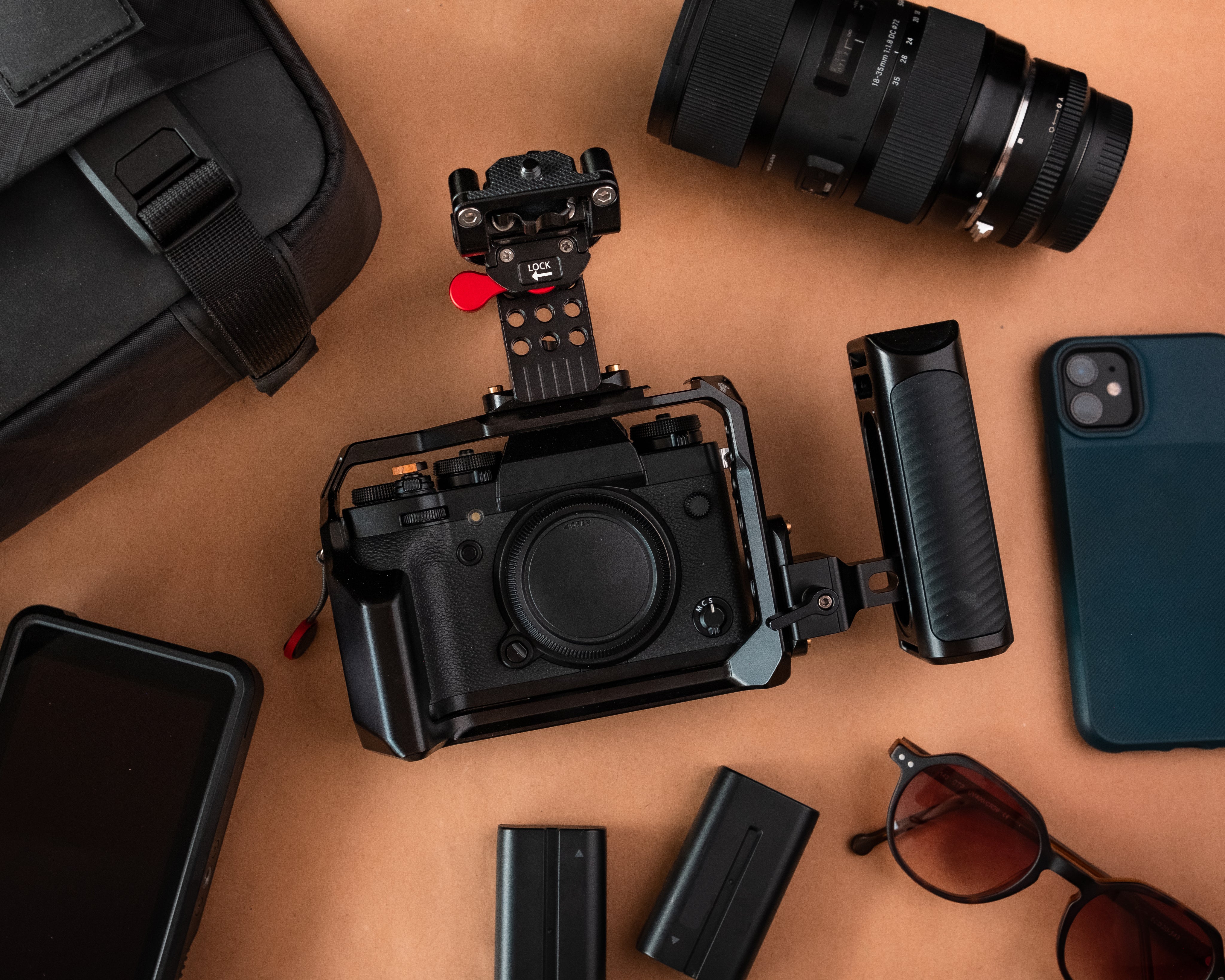Earlier today Fujifilm Global announced the all-new Fujifilm X-T4 Mirrorless camera. This camera comes in as their new flagship in their X-Series camera lineup and replaces the Fujifilm X-T3.
Fujifilm’s R&D team have taken the already brilliant X-T3 and improved it to make it one of the best APS-C cameras in the market at the moment (in our opinion).
Here’s a roundup of what’s new and improved.
Headline Features:
- 1080p video @ 240fps
- Improved autofocus with 0.02-sec focusing speeds and enhanced AF tracking
- 15fps Burst shooting mode
- Built-in IBIS with 6.5 stops of stabilisation (on most lenses)
- The camera also has Digital Stabilisation for an added boost of stability in your footage
- Larger battery capacity allowing more shots off a single charge
- Slightly larger grip for better ergonomics
- Fully articulating swivel screen
Ergonomics and ports
The X-T4 sees quite a few changes to its ergonomics and button layouts, mostly for the better (bar the exclusion of a headphone jack in-camera).

For starters, the metering dial under the shutter speed dial has now been replaced with a simple “Movie”” and “Photo” option dial. This allows for quick and easy switching between either mode. A nice added extra here is that each mode stores your settings separately. Meaning all of your settings for each mode are saved separately. This makes switching between modes a lot easier and more convenient without having to adjust your setting each time.

[Image source:
https://www.dpreview.com/reviews/fujifilm-x-t4-initial-review/3]
One thing we are sad to see removed is the dedicated headphone jack from the camera. You now have to use a USB-C adapter to use your headphones. Alternatively, you can use the headphone jack on the battery grip (sold separately). It’s not the end of the world, but for a camera aiming itself squarely in the range of a hybrid camera it is disappointing to see this feature being excluded when audio monitoring is such an integral part of shooting video.
We will need to do some tests to confirm this, but it might also mean that we would not be able to power the camera externally using a power bank at the same time as monitoring audio if you don’t have the battery grip. With the versatility of the USB-C port, you may well be able to do both at the same time with the correct adapter, but at what cost? A bulkier rig and more dongles to carry? When we get a model in hand we will update you with our findings.
The X-T4 comes in with a slightly deeper grip that its predecessor which we would think will lead to a slightly more comfortable shooting grip on the camera.
The AF-On, AE-L and Q buttons have been rearranged on the back of the camera. The AF-ON button has been extruded so it is easier to find without having to take your eyes away from the viewfinder.
The AE-L and Q Buttons have been switched around, presumably to, again, assist with on-the-fly use and not having to take your eyes off the action to locate the right button.
Of course, if you are not happy with the move, you can always reprogram the buttons in the custom ruction menu.

The Function button on the top of the camera has also been relocated to allow for easier operation. Where previously it was located in between the shutter dial and exposure comp dial which made it very difficult to access without knocking the dials. It is now in front of the exposure dial, which one should now be able to access with a small movement of your finger from the shutter button to the function button.

[Image source:
https://www.dpreview.com/reviews/fujifilm-x-t4-initial-review/3]
Along with the inclusion of a fully articulating screen (great news for video shooters) the screen itself has seen a slight improvement. It is now a 1.62 million dot touch screen versus the 1.04 million dot touch screen we saw on the X-T3. What this translates to is that the screen should allow you to see finer detail in your stills and videos.
Photography Features
There haven’t been any major changes on the image quality side that we can see. Two notable things are that the X-T4 uses the exact same sensor as the one found in the X-T3. The X-Trans CMOS 4 Sensor. Which presumably means that there won’t be much change in the image quality.
Something interesting we did pick up is the inclusion of a Tiff file format for images with the option of 16/8 bit RGB format.
We will wait until we get our hands on a unit to give more information here. But if it is anything like the X-T3 then we are expecting some fantastic image quality out of it.
Video Features
Video. This seems to be where the X-T4 sees it’s biggest upgrades being made to bring the camera even more into the running when looking between competing hybrid cameras in the market today.
Some of the most notable upgrades include 1080p at 240fps (up from 120fps in the X-T3). From sample footage we have seen, the 240fps footage doesn’t seem to be as sharp as the 120fps but by all accounts, it still seems very usable (When we get our hands on the camera we will do a real-world test of all the new features).
We also see the inclusion of a new file format for videos: MP4. Presumably this means you would be able to select either MP4 or MOV format in settings for your videos.
One of the highly sought after updates we were all hoping for is an increased recording time. From what we have been able to find, the X-T4 will offer the following recording times (accurate at time of publishing):
“[DCI 4K(4096 x 2160)] 59.94p/50p/29.97p/25p/24p/23.98p 400Mbps/200Mbps/100Mbps 59.94p/50p: up to approx. 20min. 29.97p/25p/24p/23.98p: up to approx. 30min
[4K(3840 x 2160)] 59.94p/50p/29.97p/25p/24p/23.98p 400Mbps/200Mbps/100Mbps 59.94p/50p:
up to approx. 20min. 29.97p/25p/24p/23.98p: up to approx. 30min
[Full HD(2048 x 1080)] 59.94p/50p/29.97p/25p/24p/23.98p 200Mbps/100Mbps/50Mbps up to approx. 30min.
[Full HD(1920 x 1080)] 59.94p/50p/29.97p/25p/24p/23.98p 200Mbps/100Mbps/50Mbps up to approx. 30min.
[Full HD(1920 x 1080) High speed rec.]
240p / 200p 200Mbps(recording) up to approx. 3min.
120p / 100p 200Mbps(recording) up to approx. 6min.”
[Source: www.fujifilm-x.com]
So it looks like there has been a slight boost in recording time, but we will confirm when we get the camera in our hands.
Focusing
One area that has needed a bit of a boost when compared to competitors is Fujifilm’s focusing speeds. It seems that Fujifilm have now done that. With a camera the camera boasting 0.02-sec focusing speeds. As well as improved tracking performance in group and face/eye detection.
In the sample footage we have seen, it seems to be able to lock onto a subject and hold that focus even better than the X-T3 did.
But we will wait until we get the camera in our hands and update this section with our opinions on the tracking. Overall it looks promising and should bring it closer to competing with the like of Sony.
Conclusion
Overall it seems like Fujifilm have taken into account the feedback from it’s users (something we love about them) and have implemented it to bring forward a solid upgrade to the X-Series flagship camera.
The inclusion of IBIS is a welcome upgrade to their flagship camera and could not have come soon enough. It should hopefully help slow the jump users are making to competitors for things like the IBIS and faster focusing/better tracking.
Who would this upgrade benefit? From what we can see - it will mainly benefit videographers (although it still seems to be lacking more pro-level features like waveforms & vectorscopes). But if you are looking for a vlogging camera with solid performance and great stills to boot, this should be one of the cameras on your considerations list thanks to the swivel screen and improved focusing.
Stills Photographers looking for faster focusing & better tracking speeds should also seriously consider this camera as it now seems to be more in line with competitors. But don’t expect too much more in the image quality department. The X-T3 was a solid performer and the X-T4 should be much the same with a couple more granular control options.
So should you upgrade from an X-T3 or X-T2? Well, the answer depends….
If you are primarily a stills photographer who isn’t concerned about the focusing speeds/tracking and you do most of your work from a tripod then you probably won’t see too much of a boost in your image quality straight out of the camera.
But if you are a more run and gun / on the go photographer then the upgrades and well as IBIS will be a welcome addition that might just lend themselves to helping you get the shot when you might have missed it otherwise.
If you are a videographer, the IBIS and faster slow-mo frame rates are welcome additions and should lend themselves to helping you create better videos with more unique angles without the need for things like gimbals 100% of the time.
At the end of the day, the Fujifilm cameras offer solid performance in a lightweight, rugged body at a very good price point. For most use cases we think you can’t go wrong with this camera. Yes, it would be nice to see a few more pro-level video features, but for the price point, this camera is hard to beat.
*We will update this after having done a real-world test & review.







